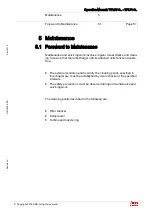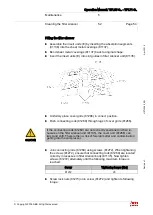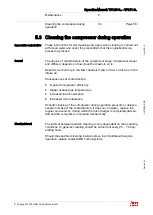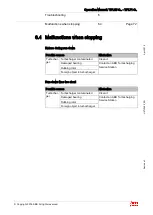
Operation Manual / TPL67-C.. - TPL71-C..
Maintenance
5
Cleaning turbine blades and nozzle ring
in operation
5.4
Page 61
© Copyright 2016 ABB. All rights reserved.
Apr
il 2016
H
ZT
L2488_
EN
R
ev
is
ion
C
Cleaning turbine blades and nozzle ring in
operation
5.4
The combustion of heavy fuel oil in diesel engines contaminates the tur-
bine blades and nozzle rings of turbochargers. The deposits on the tur-
bine components originate from the following combustion products:
Soot
Molten ash
Cinder
Incompletely burned fuel
Sodium vanadyl vanadate
It is advisable to use fuels with a low ash, sulphur, sodium and vanadium
content. The fuel must also be correctly stored, prepared and handled.
We recommend using fuels with a vanadium-to-sodium mass ratio of less
than 3:1 so that the melting temperature of the sodium vanadyl vanadate
is as high as possible.
The amount of contamination increases over time, which is why regular
and correctly performed cleaning is important in order to remove the de-
posits that have formed.
Contaminated turbine components can cause a slight increase in charging
pressure because of narrowing of the turbine cross-section. The contami-
nation causes a drop in turbine efficiency, and the engine temperatures
downstream of the cylinder can increase. The engine performance must
therefore be reduced if necessary.
The contamination of the turbine also causes rotor unbalance. Extremely
heavy contamination can lead to non-permissibly high unbalance of the
rotor.
Operating experience has shown that, in spite of regular cleaning during
operation, it is essential to carry out the overhauls during which the tur-
bine and the nozzle ring are cleaned mechanically. However, if cleaning is
carried out properly and the cleaning system is properly dimensioned, the
intervals between overhauls can be increased.
The interval between periodic cleaning is very dependent on the operating
conditions. As a rule, cleaning should be carried out every 50 to 200 op-
erating hours.
5.4
Wet cleaning interval
















































